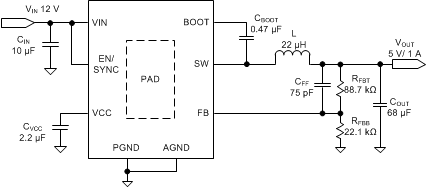JAJSEV4C December 2015 – February 2018 LMR23610
PRODUCTION DATA.
- 1 特長
- 2 アプリケーション
- 3 概要
- 4 改訂履歴
- 5 Pin Configuration and Functions
- 6 Specifications
-
7 Detailed Description
- 7.1 Overview
- 7.2 Functional Block Diagram
- 7.3
Feature Description
- 7.3.1 Fixed Frequency Peak Current Mode Control
- 7.3.2 Adjustable Output Voltage
- 7.3.3 EN/SYNC
- 7.3.4 VCC, UVLO
- 7.3.5 Minimum ON-Time, Minimum OFF-Time and Frequency Foldback at Dropout Conditions
- 7.3.6 Internal Compensation and CFF
- 7.3.7 Bootstrap Voltage (BOOT)
- 7.3.8 Overcurrent and Short-Circuit Protection
- 7.3.9 Thermal Shutdown
- 7.4 Device Functional Modes
-
8 Application and Implementation
- 8.1 Application Information
- 8.2
Typical Applications
- 8.2.1 Design Requirements
- 8.2.2
Detailed Design Procedure
- 8.2.2.1 Custom Design With WEBENCH® Tools
- 8.2.2.2 Output Voltage Setpoint
- 8.2.2.3 Switching Frequency
- 8.2.2.4 Inductor Selection
- 8.2.2.5 Output Capacitor Selection
- 8.2.2.6 Feed-Forward Capacitor
- 8.2.2.7 Input Capacitor Selection
- 8.2.2.8 Bootstrap Capacitor Selection
- 8.2.2.9 VCC Capacitor Selection
- 8.2.2.10 Undervoltage Lockout Setpoint
- 8.2.3 Application Curves
- 9 Power Supply Recommendations
- 10Layout
- 11デバイスおよびドキュメントのサポート
- 12メカニカル、パッケージ、および注文情報
パッケージ・オプション
メカニカル・データ(パッケージ|ピン)
- DDA|8
サーマルパッド・メカニカル・データ
- DDA|8
発注情報
8.2 Typical Applications
The LMR23610 only requires a few external components to convert from a wide voltage range supply to a fixed output voltage. Figure 21 shows a basic schematic.
 Figure 21. Application Circuit
Figure 21. Application Circuit
The external components have to fulfill the needs of the application, but also the stability criteria of the device's control loop. Table 1 can be used to simplify the output filter component selection.
Table 1. L, COUT and CFF Typical Values
| fSW (kHz) | VOUT (V) | L (µH)(1) | COUT (µF)(2) | CFF (pF) | RFBT (kΩ)(3) |
|---|---|---|---|---|---|
| 400 | 3.3 | 15 | 82 | 100 | 51 |
| 400 | 5 | 22 | 68 | 75 | 88.7 |
| 400 | 12 | 47 | 33 | See(4) | 243 |
| 400 | 24 | 47 | 22 | See(4) | 510 |
(1) Inductance value is calculated based on VIN = 36 V.
(2) All the COUT values are after derating. Add more when using ceramic capacitors.
(3) RFBT = 0 Ω for VOUT = 1 V. RFBB = 22.1 kΩ for all other VOUT settings.
(4) High ESR COUT gives enough phase boost and CFF not needed.